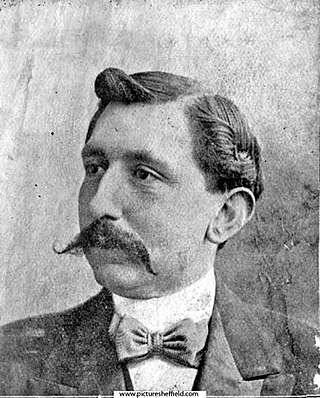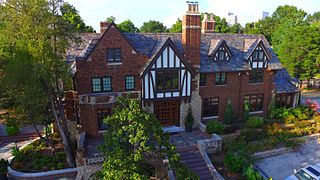Related Research Articles
The Parker Morris Committee drew up an influential 1961 report on housing space standards in public housing in the United Kingdom titled Homes for Today and Tomorrow. The committee was led by Sir Parker Morris. Its report concluded that the quality of social housing needed to be improved to match the rise in living standards, and made a number of recommendations. The Committee took a functional approach to determining space standards in the home by considering what furniture was needed in rooms, the space needed to use the furniture and move around it, and the space needed for normal household activities.
A semi-detached house is a single family duplex dwelling house that shares one common wall with the next house. The name distinguishes this style of house from detached houses, with no shared walls, and terraced houses, with a shared wall on both sides. Often, semi-detached houses are built in pairs in which each house's layout is a mirror image of the other's.

A studio apartment, or studio condo also known as a studio flat (UK), self-contained apartment (Nigeria), efficiency apartment, bed-sitter (Kenya), or bachelor apartment, is a small dwelling in which the normal functions of a number of rooms – often the living room, bedroom, and kitchen – are combined into a single room.

Sir John Tudor Walters PC was a Welsh architect, surveyor and Liberal Party politician. He served as Paymaster General under David Lloyd George from 1919 to 1922 and once again briefly in 1931 under Ramsay MacDonald.

Muchalls Castle stands overlooking the North Sea in the countryside of Kincardine and Mearns, Aberdeenshire, Scotland. The lower course is a well-preserved Romanesque, double-groined 13th-century tower house structure, built by the Frasers of Muchalls. Upon this structure, the 17th-century castle was begun by Alexander Burnett of Leys and completed by his son, Sir Thomas Burnett, 1st Baronet, in 1627. The Burnetts of Leys built the remaining four-storey present-day castle.

834 Fifth Avenue is a luxury residential housing cooperative in the Upper East Side of Manhattan, New York City. It is located on Fifth Avenue at the corner of East 64th Street opposite the Central Park Zoo. The limestone-clad building was designed by Rosario Candela, a prolific designer of luxury apartment buildings in Manhattan during the period between World War I and World War II. 834 Fifth Avenue is widely regarded as one of the most prestigious apartment houses in New York City. It has been called "the most pedigreed building on the snobbiest street in the country’s most real estate-obsessed city" in an article in the New York Observer newspaper. This status is due to the building's overall architecture, the scale and layout of the apartments, and the notoriety of its current and past residents. It is one of the finest buildings designed by Rosario Candela, according to The New York Times.

The Suntop Homes, also known under the early name of The Ardmore Experiment, were quadruple residences located in Ardmore, Pennsylvania, and based largely upon the 1935 conceptual Broadacre City model of the minimum houses. The design was commissioned by Otto Tod Mallery of the Tod Company in 1938 in an attempt to set a new standard for the entry-level housing market in the United States and to increase single-family dwelling density in the suburbs. In cooperation with Frank Lloyd Wright, the Tod Company secured a patent for the unique design, intending to sell development rights for Suntops across the country.

York Mansions is one of the seven Victorian blocks of flats on Prince of Wales Drive, London, between Albert Bridge Road and Queenstown Road, in Battersea, in the London borough of Wandsworth. The four-storey building is portered.

Tyneside flats are a form of UK domestic housing found primarily on Tyneside, including in Newcastle upon Tyne, Gateshead, South Tyneside and North Tyneside. The first known example of this type was constructed in the 1860s.

Ripley Ville or Ripleyville was an estate of model houses for the working classes in Broomfields in the West Bowling ward of the City of Bradford in West Yorkshire, England.

The Norwayne Historic District, or Norwayne Subdivision, is an historic residential subdivision, originally built for World War II defense workers. It is located in Westland, Michigan and roughly bounded by Palmer Road on the north, Wildwood Road on the west, Merriman Road on the east, and Glenwood Road and the Wayne County Lower Rouge Parkway on the south. It was listed on the National Register of Historic Places in 2013.

The William and Margot Kessler House is a private house located at 1013 Cadieux Road in Grosse Pointe Park, Michigan. It was listed on the National Register of Historic Places in 2013.

The McBirney Mansion in Tulsa, Oklahoma was the home of James H. McBirney, co-founder of the Bank of Commerce in Tulsa in 1904. He was the original owner of the mansion, built by architect John Long in 1928, and lived there until 1976. The mansion contained 15,900 square feet (1,480 m2) and sits on a 2.91 acres (11,800 m2) lot. The mansion was bought by Donna and Roger Hardesty who lived there for 5 years. Eventually it was bought by a law firm that turned it into a law office. By 2007, was purchased by former American Airlines President George Warde, who had plans to transform it into a boutique hotel. In the meantime, the McBirney Mansion was used as an event center. Warde died in 2012, and events stopped being held at McBirney. By February 2012, the Pauls Corporation, a Denver real estate management company, acquired the mansion as part of the suit's settlement. Tulsa attorney Gentner Drummond bought the mansion from Pauls Corp. in 2014, announcing his intention to make it his family's home.

Dr. Xuma's house was one of two houses to escape the destruction of Sophiatown, South Africa by the government in the late 1950s, it is also a landmark which belonged to Dr Alfred Bitini Xuma who was a medical doctor and the President of the African National Congress (ANC) and Chairperson of the Western Areas Anti-Expropriation and Proper Housing Committee. Construction of the house was completed in 1935 and named Empilweni which roughly translates to "the place of life". Xuma and his second wife Madie Hall Xuma lived there until his own property was expropriated when Sophiatown was declared a White area in terms of the Native Resettlement Act of 1954, and he had vacated it by 1957.

A byelaw terraced house is a type of dwelling built to comply with the Public Health Act 1875. It is a type of British terraced house at the opposite end of the social scale from the aristocratic townhouse but a marked improvement on the pre-regulation house built as cheap accommodation for the urban poor of the Industrial Revolution. The term usually refers to houses built between 1875 and 1918.

Public housing in the United Kingdom, also known as council housing or social housing, provided the majority of rented accommodation until 2011 when the number of households in private rental housing surpassed the number in social housing. Dwellings built for public or social housing use are built by or for local authorities and known as council houses. Since the 1980s non-profit housing associations became more important and subsequently the term "social housing" became widely used, as technically council housing only refers to housing owned by a local authority, though the terms are largely used interchangeably.

A council house or council flat is a form of British public housing built by local authorities. A council estate is a building complex containing a number of council houses and other amenities like schools and shops. Construction took place mainly from 1919 after the Housing Act 1919 to the 1980s, with much less council housing built since then. There were local design variations, but they all adhered to local authority building standards. The Housing Acts of 1985 and 1988 facilitated the transfer of council housing to not-for-profit housing associations with access to private finance, and these new housing associations became the providers of most new public-sector housing. The characterisation of council houses as 'problem places' was key for leading this movement of transferring public housing stock to the private arena. By 2003, 36.5% of the social rented housing stock was held by housing associations.

Terraced houses have been popular in the United Kingdom, particularly England and Wales, since the 17th century. They were originally built as desirable properties, such as the townhouses for the nobility around Regent's Park in central London, and the Georgian architecture that defines the World Heritage Site of Bath.
London County Council cottage estates are estates of council houses, built by London County Council, in the main between 1918 and 1939.
The Watling Estate is in Burnt Oak, in the Edgware district of the London Borough of Barnet. It was one of twelve London County Council cottage estates built between the wars to provide "homes fit for heroes". There are 4032 homes set in 386 acres (156 ha).
References
- Notes
- ↑ Tudor Walters 1918.
- ↑ Parkinson-Bailey 2000, p. 153.
- ↑ Burnett 1986, p. 222.
- 1 2 3 4 Burnett 1986, p. 223.
- ↑ Barnes 1934, p. 337.
- 1 2 3 Burnett 1986, p. 224.
- ↑ Manoochehri 2009, p. 70.
- ↑ "Council housing". UK Parliament.
- Bibliography
- Tudor Walters, Sir John (24 October 1918). Report of the Committee appointed by the President of the Local Government Board...to consider the Provision of Dwellings for the Working Class... Cd. 9191: HM Stationery Office.
{{cite book}}: CS1 maint: location (link) - Parkinson-Bailey, John J. (2000). Manchester: an Architectural History. Manchester: Manchester University Press. ISBN 0-7190-5606-3.
- Barnes, Harry (1934). The Slum: Its story and Solution. p. 337.
- Burnett, John (1986). A social history of housing : 1815-1985 (2nd e. ed.). New York: Methuen. ISBN 0416367801.
- Manoochehri, Jamileh (2009). "Social policy and housing: reflections of social values - UCL Discovery" (PDF): 413. Retrieved 18 December 2016.
{{cite journal}}: Cite journal requires|journal=(help)